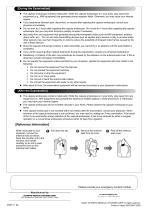 Website:
Olympus America
Website:
Olympus America
Group: Olympus
Catalog excerpts

Cautions for Capsule Endoscopy Patient Your physician has determined that you should undergo an examination called “capsule endoscopy” as part of your medical evaluation. The OLYMPUS CAPSULE ENDOSCOPE SYSTEM is indicated for visualization of the small intestine mucosa as an adjunctive tool in the detection of abnormalities of the small intestine mucosa. The Red Color Detection Function is intended to mark frames of the video suspected of containing blood or red areas. The capsule endoscope (Olympus EC type 1) has only been studied in patients with obscure gastrointestinal bleeding. Obscure gastrointestinal bleeding is bleeding of an unknown origin or source that persists or recurs in the small intestine. The analysis of acquired capsule images requires a physician trained in endoscopy. You will be asked to ingest the Olympus EC type 1 for this examination. The capsule takes pictures as it moves through your digestive system. The pictures are transmitted from the capsule via the 8 antenna pads attached to your abdominal area to the recorder unit secured on your waist. All the pictures are stored on the recorder unit. The antenna lead set and the recorder unit are removed after about 8 hours and the recorded images are viewed by a physician trained in endoscopy. The image recording time of the Olympus EC type 1 is 8 hours and the Olympus EC type 1 may not transverse the entire small bowel during that time. Therefore, it is possible that the examination of the small bowel will be incomplete. It is important that you follow the instructions below to attach the equipment properly and prevent equipment damage and/or failure so that your physician can obtain accurate results. During the examination, there is a slight possibility of unexpected retention of the capsule. In the worst case, surgical removal of the capsule may be required. Patients with one of the following conditions cannot undergo the examination. – Patients with a cardiac pacemaker, implanted cardiac defibrillator or other implanted electronic devices. – Patients with known intestinal strictures, adhesions, diverticulum, obstruction or fistulas that may block the passage of the capsule endoscope. – Patients with significant difficulty in swallowing a tablet as large as capsule endoscope. – Patients with known swallowing disorders. – Patients who cannot undergo surgery to remove the capsule when retention of the capsule occurs. – Pregnant women. – Patients with known significant delay in passing through of the capsule endoscope in the gastrointestinal tract. – Patients diagnosed as radiation enteritis. Capsule endoscope (OLYMPUS EC TYPE 1) The recorder unit secured on your waist. [Before the Examination] You must abstain from eating or drinking (but if necessary, minimum quantity of water may be taken) 8 hours before the examination. If you are on medication, please consult your physician(s) to determine if added precautions need to be taken during and/or after the examination. Your physician may wish to give you an intestine cleansing agent (laxative, gastrointestinal lavage) as a part of this examination, in such a case, follow your physician’s instruction. Avoid wearing a dress or a one-piece-suit. Wear a separate top and a bottom so that the antenna lead cables can be connected to the recorder unit that is fitted to your waist. Your body hair may need to be shaved in order to securely adhere the antenna leads. Adhesive covers will be used to attach the antenna leads to your abdominal area. The antenna lead must not be removed for about 8 hours. If you experience any discomfort (i.e., skin irritation or pain) while the antenna lead is attached, please inform your physician. Ingest the capsule endoscope with a sip of water. Do not bite the
Open the catalog to page 1
[During the Examination] The capsule endoscope contains metal parts. While the capsule endoscope is in your body, stay away from equipment (e.g., MRI equipment) that generates strong magnetic fields. Otherwise, you may injure your internal organs. If you experience stomach pain, discomfort, or nausea after ingesting the capsule endoscope, consult your physician immediately. Do not drink for 2 hours after ingesting the capsule endoscope. Do not eat for 4 hours after ingesting the capsule endoscope. But you may drink minimum quantity of water if necessary. Stay away from any equipment that...
Open the catalog to page 2All Olympus America catalogs and technical brochures
-
Olympus Endo Capsule Update
2 Pages
-
EasySuite® 4K
8 Pages
-
CF-HQ190L/I
2 Pages
-
GIF-1TH190
2 Pages
-
GIF-H190
2 Pages
-
GIF-HQ190
2 Pages
-
MAJ-2022
2 Pages
-
ALT-Pro
2 Pages
-
V-System Family Brochure
10 Pages
-
Rigid ENT HD Sinuscopes
3 Pages
-
HiQ Series
13 Pages
-
HD Endoeye
4 Pages
-
ENT Family brochure
12 Pages
-
BF-1TQ180
2 Pages
-
BF-1T260
2 Pages
-
BF-Q180
3 Pages
-
CF-HQ190L
2 Pages
-
PCF-H190LI
2 Pages
-
PCF-PH190LI
2 Pages
-
TJF-Q180V
2 Pages
-
GIF-XP190N
2 Pages
-
EC-1
7 Pages
-
CF-Q165I/L
2 Pages
-
CF-H190
3 Pages
-
BF-XT160
2 Pages
-
BF-UC180F
2 Pages
-
EVIS EXERA III
7 Pages
-
BF-PE2
3 Pages
-
BF-P180
2 Pages
-
BF-N20
2 Pages
-
BF-MP60
2 Pages
-
BF-MP160F
4 Pages
-
BF-H190
2 Pages
-
BF-1TH190
7 Pages
-
BF-1T180
2 Pages
-
GIF-H260
3 Pages
-
GIF-FQ260Z
3 Pages
-
BF-F260
4 Pages
-
magazine (2008)
48 Pages














































